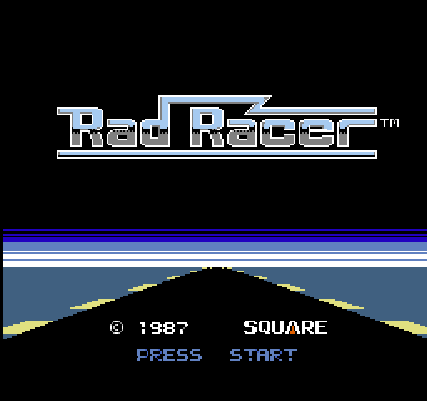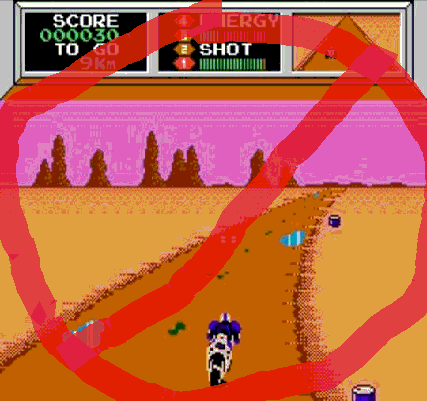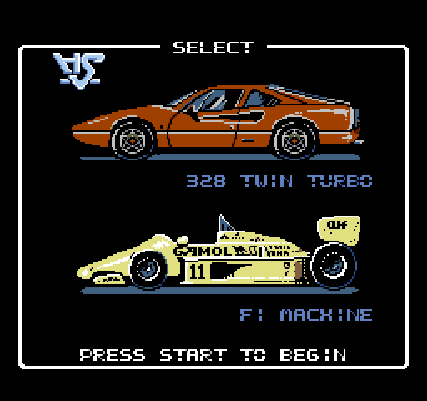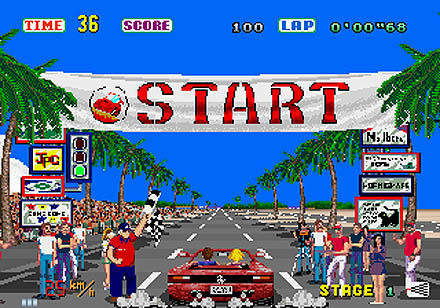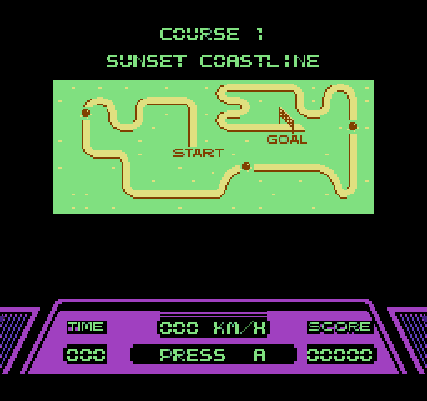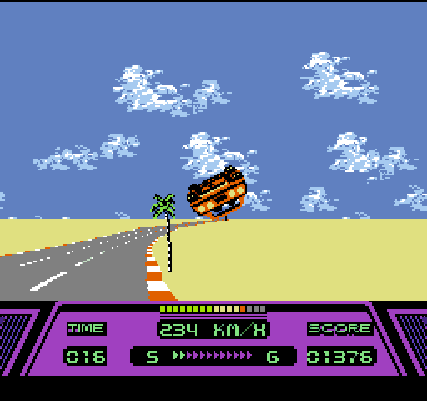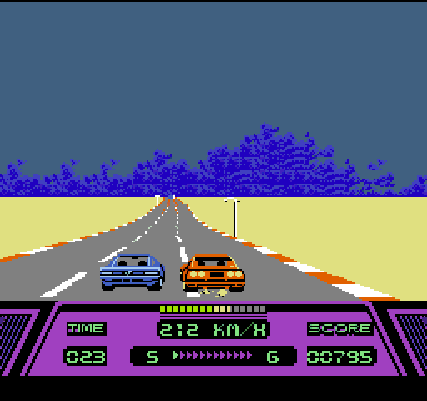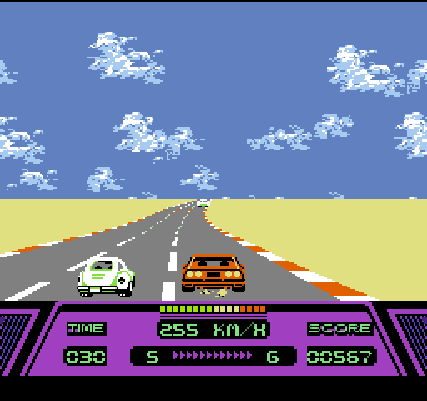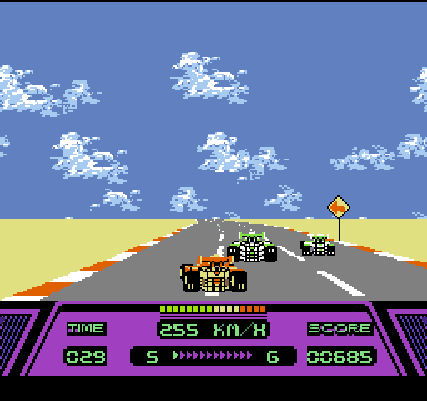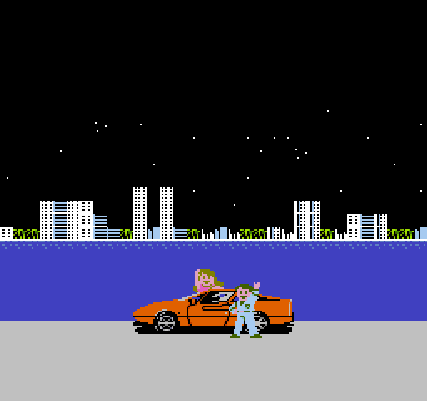The Fair Shake
Rad Racer
 Greetings readers! Once again, welcome to “The Fair Shake”. As you can see above, I now have a wonderfully illustrated logo for my little electronic lean-to here at 1More Castle. Massive amounts of thanks once again go to my artistically gifted friend, Joshua Reinke. I think our gaming salt shaker needs a name, so I have an idea. Best name listed in the comments below will be chosen!
Greetings readers! Once again, welcome to “The Fair Shake”. As you can see above, I now have a wonderfully illustrated logo for my little electronic lean-to here at 1More Castle. Massive amounts of thanks once again go to my artistically gifted friend, Joshua Reinke. I think our gaming salt shaker needs a name, so I have an idea. Best name listed in the comments below will be chosen!
Could I entertain you with a short game of Jeopardy? The answer is ‘Airships. The Light Warriors. A Ferrari 328. An ‘F1 Racing Machine”. If you guessed “What are characters or things from a game programmed by Square”, I award you +500 Internet Points. Square? Yes, that Square. The creator of all things Final Fantasy and later, as Square Enix, Dragon Quest, actually released a racing game back in the 1980s. This week at The Fair Shake we’ll be discussing Rad Racer, the first racing game released for the Nintendo Entertainment system, back in the fall of 1987. For people of a certain age, this was the first racing game that they ever played on the NES. (You there in the back, Mach Rider doesn’t really count as a pure racing game… sit down.)
Rad Racer follows in the footsteps of Night Driver, the first third person driving game from Atari, and Enduro, the addictive racing game from Activision on the Atari 2600, with a little bit of Pole Position from Namco thrown in. This is a fairly simple arcade style racing game, but I suppose one could say that solitaire is a fairly simple card game, easy to pick up the basics but challenging to complete. After the initial title screen, the player is presented with the side view and choice of driving as either a Ferrari 328, or a F1 Racing Machine. (While the Ferrari is listed as a 328, I always liked to think it was in fact a Ferrari 308, so I could fulfill my Magnum P.I. fantasies, but I digress.) The only difference between the two cars in the game are cosmetic. Both cars accelerate, handle, and top out at the same speed.
Fun Fact: if you have ever wondered why the icon for car selection reads “HS”, look to Japan. This game was initially released in Japan as “Highway Star”. I’ve often wondered if this has anything to do with the Deep Purple song. The goal is to complete eight courses while racing against a timer that resets as checkpoints are passed. Points are awarded as you drive. A small progress bar fills as you complete the course, going from S ‘Start’ to G ‘Goal’ Passing a checkpoint causes a predetermined amount of time to be added back to the clock. Other cars are present on the course, however you are not racing them directly for position, as they are only moving roadblocks to be passed. There are no ‘lives’ in the conventional sense of the word in this game. Crashing into other cars will cause your vehicle to slow down or slide off the track, while hitting an obstacle off either side of the road will cause you to flip over in a spectacular fashion, stopping you for a few seconds until your car is brought back onto the track by an unseen invisible hand (this hand is assumed to be different than Adam Smith’s invisible hand, for you economics majors). One might ask how does one crash without dying, wrecking the car, etc, fear not! The game manual spells it out clearly! A ‘Protective Ceramic Overcoating’ keeps the car safe. I’ve had a few cars over the years that could have used that ‘overcoating’ during an accident.
If most of the preceding paragraph sounds like another game, you’d be correct. Out Run was released by Sega a little over a year before Rad Racer, and Rad Racer has often been described as a NES answer to the popular Sega driving game. The games are indeed very similar, but they different enough to provide unique play experiences. Out Run is graphically more vibrant, colorful and offers more play control, at least when dealing with an actual arcade machine that utilizes a steering wheel. Compared to later home releases of Out Run, however, Rad Racer always had an intangible ‘smoothness’ that could not be matched. Both games even have the driver with the requisite ‘hot female’ along for the ride as passenger. I’ll let the Sega/Nintendo fan boys duke it out, but each are enjoyable on their own merits.
Rad Racer has eight stages with each representing a different area of the world. If you chose to play as the Ferrari, each stage has a different opponent car, from a set of VW Beetles to Corvettes and ending up in stage 8 with Ferarri Testarossas (Can we pretend it’s Miami Vice vs Magnum P.I.? Please? Ok fine…), while with the F1 car the opponent cars are all F1 cars of varying colors, similar to Pole Position. Track difficulty increases with each stage, as does the opponent drivng skill, as they make attempts to actively block your driving and cause you to crash. Stage four has the computer controlled cars changing lanes for the first time. Officially, there is no way to continue if you fail to complete a race, however pressing A and start simultanously after losing a race will cause you to repeat the last stage while resetting points to zero. Crashing is always amusing as the car flips about twenty five feet into the air doing barrel rolls years before Slippy told you to.
For a Nintendo game released relatively early in the consoles life, the graphics of Rad Racer are very good. Some flickering of computer cars is evident if there are several on the screen. The 3d effect feels rather gimicky compared to today’s games, but I would say it’s worth getting a pair of plastic glasses to try. I haven’t tried this on a modern LCD/flat screen, as my game room in my house has an old 22″ tube TV. Japanese Famicom players were treated to the use of optional “3D System” goggles. These were shutter glasses very similar to the Sega Master System 3D glasses. US players were never offered these glasses, and instead were treated to cheap 50’s style paper 3D glasses with red and blue tinted plastic lenses. The player cars and enemies are for the most part, identifiable as what they are supposed to represent (curse you stage eight Ferrari Testarossa always in my way.. you know who you are!) The road looks like a road, and each level has it’s own distinct feel. Perhaps if Athens held an annual race around the ruins like the course in stage four, their economy would be a little better!.. Too Soon?
Sound effects are pretty decent for an early NES game. Even though the car is an automatic, it’s still fun to watch the bar tachometer (Editor’s note: This does not measure mexican food; I googled it) fill up and listen as the engine revs and ‘shifts’. There are three melodies to choose from in the game, selectable by pressing down on the control pad. Each is unique in feel and sound, despite being bereft of Deep Purple. My favorite is the first song, but when crunched for time I have been known to let the third one play. The crash noises and skidding sound realistic enough to let the player know what’s going on if you play with the music off. Play control is excellent for a driving game on the NES. Not much here except brakes, a throttle and a turbo function. Like all NES driving games, a steering wheel or paddle controller would have immensely improved the game experience. Pushing up on the controller causes a sort of turbo function as the car accelerates to top speed quicker. The entire screen vibrates a bit when pressing up and the tone of the engine becomes a little more intense and deeper, giving the impression that some serious power is being applied to the pavement.
This was the first racing game of any kind I had for the NES, other than Excitebike. Before writing this article I only intended to play for five minutes or so to refamiliarize myself with the game, but found myself drawn in for a half hour. How does that happen? I forgot how the game melody stops when crashing and restarts once the car is back on the track. Oh my, the suspense! My only real disappointment with this game is the lack of any two player mode. I suppose this was due to programming knowledge at the time, as later games such as Michael Andretti World GP on the NES did have it, to the delight of both me and my father. One major negative of Rad Racer is the sad fact it has probably caused more thumb cramps than any other game due to the constant pressure of pressing up. Sure, there’s no need to press it once the car tops out at 255 KPH, but who really ever lets go of the turbo? A different controller such as the NES Advantage, or a snap on joystick for the NES game pad alleivates this issue. As a child, it always annoyed me that the brake lights didn’t function on the car, while they did on Out Run.
There are a few hints to help a would be Rad Racer reach the end of stage eight. Hitting an opponent on center will cause you to match his speed and not crash. Hitting an opponent off center will cause your car to slide across the track. This can be useful in a turn. Once again, like most NES games, there are also some hints in the game manual. My favorite is “Never forget the limits of your car.” Best of all, this game actually has an ending sequence that is fairly amusing, so you’ll even get something to enjoy after completing all the courses. If you are looking for a relatively simple racer with some challenge for the NES then hop in your Ferrari, set the radio to song A, get ready for a world tour provided by Square, and give Rad Racer a go!
About that ‘hot redhead’ I mentioned? You’ll have to find her in the game. She’s there, I promise. Don’t let her do to you what she did to me. I warned you.
